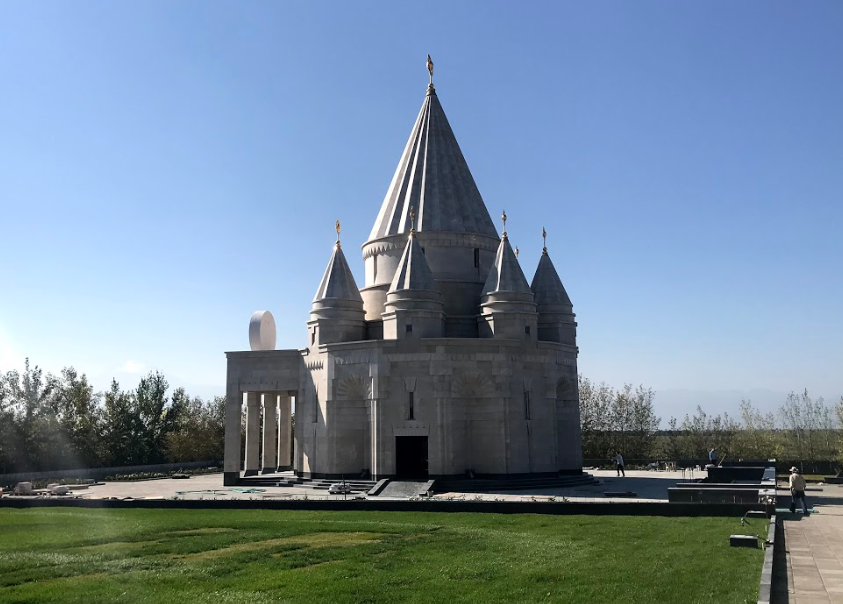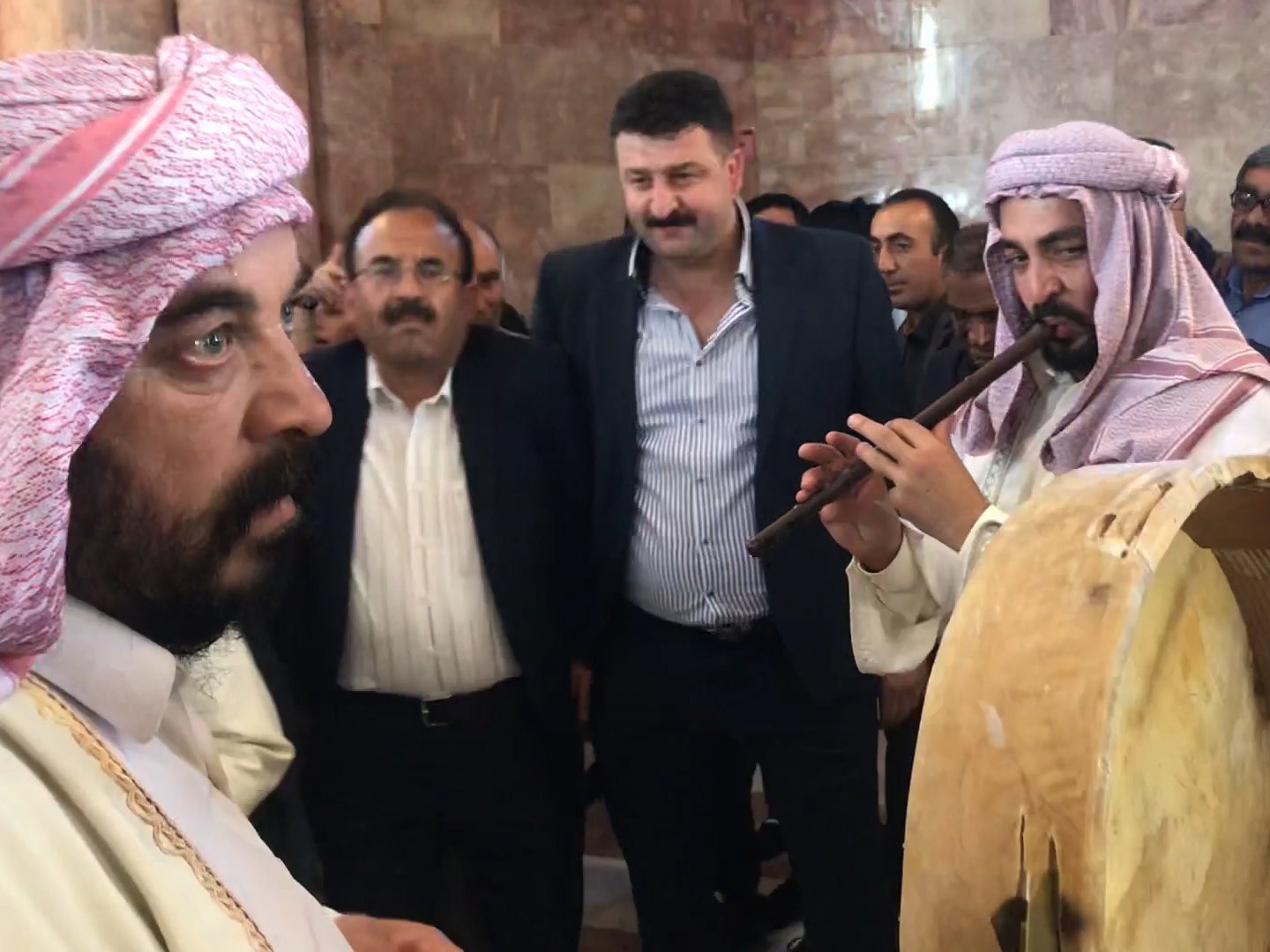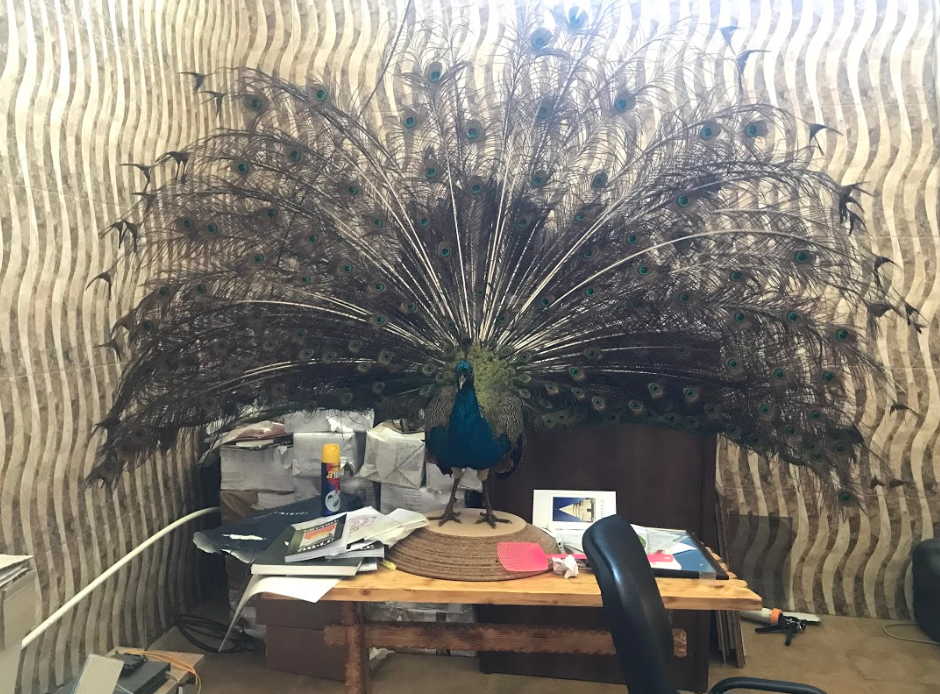Emerging from Isis genocide, Yazidis in Armenia open religion’s biggest ever temple
In the opening part of her new series, , this year’s winner of The Independent’s Rupert Cornwell prize for foreign journalism, travels to Aknalich, Armenia, to report on the opening of the biggest Yazidi temple in the world and finds a community attempting a renaissance


In the sleepy Armenian lakeside town of Aknalich, crowds gathered for the opening of a new temple. Inside the vast vaulted stone building, musicians dressed in ivory coloured cotton garments and rolled headscarves processed in a circle. Some chanted sacred hymns, while others played the drum and flute. Those gathered around them danced shoulder to shoulder.
These musicians are known as qewwals, singers of the ageless, orally transmitted sacred songs from the Yazidi religion.
Yazidis are a Kurdish-speaking religious minority, whose main population is concentrated in northern Iraq. In 2014, Isis militants killed, kidnapped and displaced thousands from their community. Today, this ancient minority is extremely fragile and scattered across the globe.
Yazidis agree on the ancient roots of their religion, but not on the details of these origins. The religion is monotheistic, and their principal saint is the 12th-century Sufi mystic Sheikh Adi ibn Musafir, who was buried in a temple in Lalish, the religion’s main pilgrimage site in northern Iraq. Academics also point to connections with ancient Iranian religions.
This arid and sparsely populated Armenian province might at first seem like an unusual place for such a temple and ceremony. Yet Yazidis are the biggest minority in Armenia, where over 80 per cent of the population is Christian and ethnic Armenian. In the last census in 2011, the Yazidi population in Armenia numbered at 35,000.
“We don’t have a homeland, but our traditions are safe here in Armenia,” says Temur Akmiyan, a villager from the province.
The qewwals live only in the Yazidi heartland of northern Iraq. But they have come here to Armenia for the opening of Quba Mere Diwane, the biggest Yazidi temple in the world, and only the third modern temple outside of Iraq.
“We’ve come to sing sacred songs and play music to consecrate the temple. There are no sacred singers in Armenia, that’s why we’re here,” says Qewwal Ziad.
Event organisers estimated that over 20,000 people attended the opening day, from former Soviet Union countries as well as Europe. A delegation from Iraq included members of the Yazidi spiritual council and Yazidi military men. Representatives of the Armenian church, government officials, army veterans and the heads of Yazidi organisations in the US and Germany also attended.
For the visitors from the Yazidi diaspora communities of the former Soviet Union, this encounter with the Iraqi qewwals could be the first in generations. Throughout the morning, people approached them to take group pictures. As they processed inside the temple, crowds gathered to film the ceremony.
But the singers weren’t the only novelty. Reha, an elderly Armenian Yazidi from a nearby village, admired the embroidered white silk scarf worn by an Iraqi woman, “I can’t find scarves like this here. I’d like one to wear at weddings,” she sighs.
Behind her, erect with eight spires and glistening white stone, was the massive new temple.
“What’s not to like?” asks Reha, “Have you been inside?” Like many elders from her secretive community, Reha is cautious when speaking to journalists. The view led to Mount Ararat, a mountain on the eastern border of Turkey, which many Armenians consider a symbol of their nation.

Yazidis have no holy book, and the religion’s sacred texts were passed on orally by members of their religious castes, who keep the details of the religion a secret. In the past, this oral tradition was preserved by close-knit tribal communities. But today this religious knowledge has weakened as a result of ongoing migration, modernity, and conflict in Iraq, Syria and Turkey.
In Yazidi creation stories, the world was created by light. As such, followers pray facing the sun, believing sunlight to be an emanation of God. Their archangel, melak el tawus, takes the form of a peacock. They do not accept converts, and are required to marry within the religion in accordance to the strict caste system. Their population numbers today, estimated to be around 700,000 globally, are dangerously dwindling.
Until recently, Yazidis did not build temples outside of their heartland in Iraq. As well as the temple at Lalish, hundreds of smaller shrines also exist in Iraq close to Yazidi villages.
“For a religion that does not have a book, these shrines helped preserve the religion, serving as points of confluence and pilgrimage for their communities,” explains Tyler Fisher, of the University of Florida, who researches the reconstruction of Yazidi temples in Iraq.
Now scattered, Yazidis of the former Soviet Union are the first among the community’s ever-growing diaspora to build modern temples. A smaller temple with a single spire was first opened in Aknalich in 2012. This was followed by a temple and religious centre in Tbilisi, the capital of Georgia, which opened in 2015. These three temples were recognised by the Yazidi high spiritual council in Iraq, according to their organisers.
Yazidi living in Anatolian provinces of the Ottoman Empire – which today is eastern Turkey – began migrating to Armenia in the 19th century. And then in 1915, entire Yazidi villages fled genocidal campaigns against non-Muslim minorities of the collapsing Ottoman Empire, settling in Armenia.
Up to 1.5 million Armenians are thought to have been killed in these campaigns. Under the Soviet Union, religion was banned, but Kurdish-speaking communities of Armenia and Georgia, who were predominantly Yazidi, received support to develop their culture, language and folklore.
The absence of buildings for worship was particularly felt in the Caucasus. Yazidi communities were cut off from their main pilgrimage site, Lalish, in northern Iraq for over 100 years.
“I’ve never been to Lalish, we know it from our songs and its stays in our hearts,” says Anahit Sharuef, a Yazidi poet from a nearby village. Instead, Yazidi rituals in the Caucasus centred around the home and their cemeteries.
Since the collapse of the Soviet Union, the church has played a powerful role in Armenia and Georgia, further weakening the religious minority’s sense of identity. Many Yazidis often visit churches to light candles, and kept Christian iconography in their homes.
In the home of Armenian Yazidi villager Murad Usoyan, I spotted images of the Virgin Mary. “She’s the Khatuna Fekhra, our Yazidi angel,” he explains. “Our religions have many parallels.”
Further, economic hardship in post-Soviet Armenia is weakening the community’s presence. Like many Armenians, Yazidis began migrating to Russia and Europe after the collapse of the Soviet Union. By 2011, the Yazidi population of Armenia had dropped by 30 per cent. Today, many isolated villages in which Yazidi traditions were preserved are mostly empty.
“If we don’t build temples outside of Iraq, we will lose our religion and our culture,” says Ruslan Jawoyan, an Armenian-born Yazidi living in Moscow, who was at the opening.
On the week of the opening, a small temple-like shrine was inaugurated in the isolated village of Sorik on the Armenian-Turkish border, and another religious building was nearing completion in the village of Riya Taza in the Aparan region of Armenia.
If we don’t build temples outside of Iraq, we will lose our religion and our culture
Yazidi temples consist of one or two conical spires, or quba, each representing a Yazidi saint or angel. The spire has 12 or 24 ridges, and it ends in a circle symbolising the sun. The temple’s base is rectangular or square, with either a flat or vaulted roof.
Hussein Hajji Othman, an Iraqi Yazidi writer who has come to Armenia for the opening, explains the spiritual significance of this architecture.
“The temples are built from the ground to the sky. The bottom has four corners, representing chapters of peace. Above it, the spire simulates the sun beams. Everything above the spire is sunlight. Yazidis say that the sunlight is goodness, it is the source of life.”
With its eight spires, the temple at Aknalich deviates from this traditional model. A central spire symbolises the Yazidi archangel Melak Tawus. It is surrounded by seven smaller spires, each dedicated to an angel. At the top of the entrance is the elaborate stone carving of a sun – a modern invention made specifically for this temple.
The temple’s Yerevan-based architect, Artik Ghulyan, was influenced by ancient Armenian churches, whereby a central dome is surrounded by a series of smaller ones. Ghulyan introduced modern elements, such as a series of triangle-shaped motifs along the outer walls, which symbolise sun rays. “It recalls the ancient Mesopotamian cultures of Iraq,” he says.

The spire of Yazidi temples is topped with a brass icon, which is traditionally shaped as a crescent moon or a hand. However, all eight spires at Aknalich are topped with a brass sun. “The crescent moon symbol feels increasingly alien to us, particularly since the attacks from Islamic State,” says Dilman Jihad Qewwal Murad, another qewwal from Iraq. But other spiritual leaders are known to have opposed the sun-shaped icons at Aknalich, preferring the crescent moon or hand.
Inside are seven large sun-shaped chandeliers, and the icon of a peacock made of semi-precious stone. Colourful satin fabrics were laid out on an altar-like table facing the peacock. The visitors gathered around the table, kissing the fabric or tying knots to it. A visionary spiritual leader from Iraq known as a kochek blessed the visitors.
Yazidi temples are often connected to a burial ground. “Where a village does not have a temple, they will construct a small shrine by their cemeteries,” says Fisher. Likewise, the first temple at Aknalich was built adjacent to a local Yazidi cemetery.
The grounds also serve as a memorial park for Armenian and Yazidi history. With its stone monuments dedicated to war heroes and intellectuals, it is reminiscent of Soviet-era memorial parks. It includes a sculpture and tombstone for the Yazidi war hero Janghir Agha, who led victorious battles against the Turks in Armenia in 1918. And a monument to the “Armenian and Yazidi Friendship” brings together the symbol of a Yazidi peacock with a Christian crucifix.
A new monument commemorating the genocide of 2014 was unveiled on the opening day. It is the sculpture of Yazidi activist Nadia Murad, a former Isis captive and Nobel Peace Prize Laureate. Visitors placed white flowers at the foot of the sculpture and prayed.
As such, many view the temple as a modern expression of Yazidism in the Caucasus. “There’s been a renaissance of sorts. It’s not just about religion, it’s also about identity,” says the Yerevan-based Yazidi academic Tereza Amryan.
The temple will stand for hundreds of years
The new temple is also part of a wider trend in post-Soviet states, whereby successful businessmen from the diaspora build religious edifices in their home towns and villages. The economic and political vacuum following the collapse of the Soviet Union, as well as lawlessness and organised crime, spelt extreme poverty for most and riches for the very few. Over 200 new churches are said to have emerged in Armenia since the 1990s.
The temple’s sponsor, the Moscow-based businessman Mirza Sloyan, who owns a shopping mall in Moscow, was born near Aknalich. “This enormous building is my latest project,” he says, pointing back towards the temple that was still under construction, just days before the opening.
In response to the Isis attacks in 2014, he also founded the All Russian Yazidi Congress in Moscow, and the online video channel Lalish TV, which covers Yazidi news and culture globally.
No expense was spared. “We lost track of the budget long ago,” says Hamlet Boghossian, who supervised the stone work. A stonemasonry workshop was installed next to the temple grounds, to carve durable marmarit stone that was imported from Iran. “The temple will stand for hundreds of years,” says Boghossian.
“So many of our temples were destroyed in Iraq by Isis militants in 2014. That’s when I decided we should have a bigger temple here,” says Sloyan.
Inside a newly built reception hall in the temple grounds, Sloyan talked about his childhood in the Soviet Union. “Armenians didn’t have to go to work. Instead, they said: ‘Look at the face of a Yazidi person and you’ll find success’,” he recalls, a popular trope about Yazidis bringing prosperity. He rested back against his armchair, occasionally swatting passing flies. To the table on his left, was a glistening taxidermy peacock with all its feathers.
“As a child, I saw the religious institutions that the Armenians had, and I wondered why didn’t we have such a place,” he says.
Sloyan, who is now in his mid-70s, became interested in the Yazidi religion and culture in his later adult life. “Our language is so complex. For example, we have a different word for how humans sit, how dogs sit, how lions sit – and many other animals” he says. “The more I learn, the more it fascinates me.”
His first journey to Iraq, he said, was for a pilgrimage in 1994. This was also a time when Kurds from former Soviet countries joined partisan groups operating from war-torn northern Iraq.
“We flew from Moscow to Istanbul, then to Diyarbakir, and from there we drove across the border into Iraq,” he recalls. “Of course it was dangerous, but I went anyway. And I visited Iraq again during the recent war.” His aides say that he was supporting refugees in the recent crisis.
Today, Sloyan maintains relations with Iraq’s Lalish Brigade, a Yazidi militia that is supported by the Iran-backed paramilitaries, known as the Hash’d Al Shaabi. The brigade’s leader, Ali Serhan Issa, was among the official guests from Iraq at the opening.
Building the temple in Armenia was essential, Sloyan says.
“Armenia is the safest country in the world for the Yazidi people. I’m happy I built it here, facing Mount Ararat. My grandchildren will also be proud.”
However some Yazidi religious figures opposed the new temple. Sheikh Hasan Tamoyan, an influential cleric and current president of the Yazidi National Union of Armenia argues that these new temples go against Yazidi religious teachings.
“Our religion does not accept worshipping stone and wood. We believe in the sun and its light,” he said. Even the mausoleum at Lalish, he explains, is not a place for worship. “It’s where Yazidis go to pay respect for their dead Saints.”
Sheikh Hasan did not attend the opening, and I met him at his home in a suburb of Yerevan. Religious leaders interviewed for this article often had golden peacock figurines, paintings, and mini models of Lalish adorning their living rooms like icons. By contrast, Sheikh Hasan’s home had no visible religious symbols.
“Our holy texts do not tell us to worship replicas of peacocks,” he says. “It’s a form of totemism. I hope our community will one day look beyond the superficialities of our modern times.”
“Yazidis have only two places for prayer. First in the morning they should stand in front of the sun, facing the east and far from strangers. Their prayers should be discrete and not demonstrative,” he explains. “Then we have special places to pray in our homes.” He pointed to the ster, a colourful stack of folded mattresses which, among Yazidis of the Caucasus, is considered sacred. Sheikh Hasan, his wife and his children stood in front of the ster to pray, then kissed the fabric.
“The building of new temples such as the one in Aknalich aspires to imitate Christianity.”

Yet no religious opposition could curtail the excitement felt on the opening day at Aknalich.
“This is an important and historic day for the Yazidi people,” says Barfa Tamoyan, an Armenian-born Yazidi now living in France. Despite the heat of the opening day, she wears a voluminous black ball gown and velvet heels to mark the special occasion. “We have built a temple in a country that is not our homeland. I hope we’ll have temples in Europe in the future.”
In the gardens, well-known Yazidi bands from Russia and Germany played ceremonial songs, while crowds continued to pour in an out of the temple, filming the event on their phones, and taking selfies and group photos with friends and family.
In lyrics composed for the opening day, Aydin Amara sings, “Come to the temple to a place of prayer and worship. To the Yazidi temple, from which heaven blows.”
Join our commenting forum
Join thought-provoking conversations, follow other Independent readers and see their replies
Comments
Bookmark popover
Removed from bookmarks